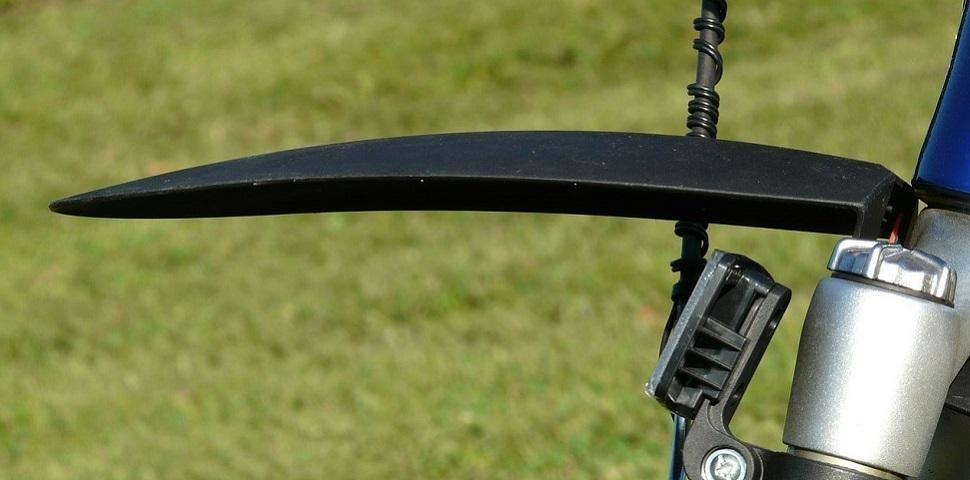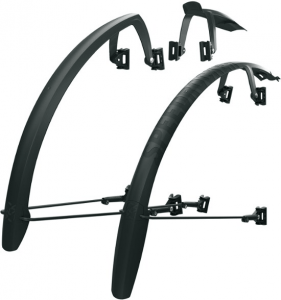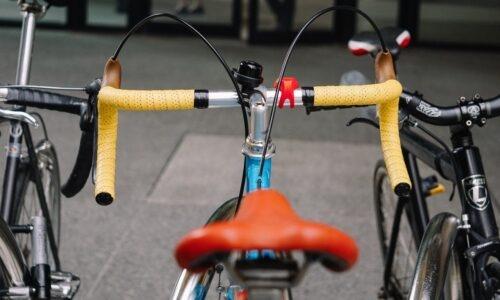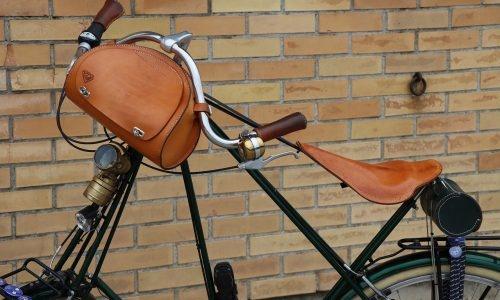In this article, we will talk about a key component for your bike, the importance of which cannot be fully understood until you find yourself really needing it.
That component is the fender or mudguard. What is the difference between them? They are synonymous, so it depends on which side of the Atlantic you reside.

It may not be the most interesting component for your mountain bike, certainly not as interesting as the latest full-suspension mountain bike, but equipping a fender on your mountain bike will increase the useful life of your new and spectacular suspension, and many other components of your bike.
Therefore, it is not only protection for the bike, but it is also important protection for you. Fenders are important not just for keeping you dry, clean, and comfortable, but also for keeping your buddies behind you from getting sprayed with mud and water.
Therefore, if you want to come back home without looking like a mud man and keep your bike functioning well we recommend that you get one of the fenders that we have selected for you in this article.
But first, we want to explain the types of fenders in the market, and how to choose the best one for yourself.
Are there different types of fenders?
In the market, we find different types of fenders, with some of them covering a large area of the wheel while others are being small and light and are placed to protect some specific components of the bike.
In the next lines, we will see the pros and cons of each of them. Another point to consider is that fenders can be placed on both the front and rear wheels.
Therefore, we have to be very clear about what we want to use the fender for and what we want to protect with it.
Rear fenders: These fenders can be attached to the saddle of the bike, the seatpost, and the wheel. Their main function is to protect the back of your body from the mud. Let’s break down the different types:
- Attachable under the saddle: These are fenders that will only protect your back, but as an advantage, they are very simple to set up, lightweight, and small. In other words, they are incredible!
- Attachable to the seatpost: In this case, the fender is in a lower position, closer to the wheel, which will give us greater protection. They cover a larger area of the wheel, so they are going to be longer than other types. They easily adjust to the seat post, so you can assemble and disassemble them in a matter of seconds.
- Attachable with hook-and-loop and rubber straps: These are the largest we can place on the rear wheel. They offer us a lot of protection against splashes of mud, but they are less light and could be blocked with a branch.
Front fenders: These fenders are attached to the front fork and have an important function on the maintenance of the bike. They will protect the fork, frame, and drivetrain from mud splatter.
- Enduro: This type is similar to the Ass Saver, but they are equipped to the front fork, protecting your chest and legs from splashes, while also protecting the fork joints and mud suspension. Lightness and aerodynamics are its biggest advantages.
- Full protection: These fenders are also coupled to the fork, but they are much larger than the enduro and offer optimal protection. Your fork and suspension will be completely covered and protected. In some of these fenders, you can choose whether to equip only the front, the rear or both.
- Race Face Mud Crutch: An original way to protect our fork from the mud. Acting like a shield, this type of fenders offers sufficient protection so that the fork and suspension of our bike do not suffer from the mud. Very light but offers little protection to the cyclist.
What should we consider when choosing our fenders?
We may think that there is nothing to consider when choosing our fenders since they are just an anti-mud “shield.” But if we do not choose the right fenders, we can have problems if they touch the tire, and so we would not be able to use them.
Therefore, before buying a fender for your mountain bike, it is important to assess three fundamental aspects: size, compatibility and ease of assembly/disassembly.
- Size: The size of the fender will make it offer more or less protection against dirt. If you have an MTB with 29-inch wheels, you will have to buy a larger fender than if you have a 26-inch wheel bike.
- Ease of assembly/disassembly: Another key aspect is to choose a fender that can be easily assembled and disassembled. In this way, you can remove it on sunny days and install it when the ground is wet or there is a possibility of rain.
- Compatibility: The compatibility of the model with your bike is very important so you can install the fender. In general, there are no problems with the rear fender, as it hooks to the saddle tube or the saddle itself. But there are usually more incompatibilities with the front fender, as many models have to be held in the fork hole and not all of them are wide enough.
- Pieces and position: It is important to know if what we want is a fender that only covers the front of the wheel, the part behind the fork, both, or just the fork. Taking this into consideration, we have several options that will work for you.
What are the best fenders and mudguards on the market for a mountain bike?
For our selection, we wanted to choose fenders/mudguards of all the types described above. Let’s start!
1. Ass Savers
The first fender of our selection is probably the simplest. Designed by the Swedish brand Ass Savers, the task they have is to protect the back of your body from the splashing due to the rear tire.
It easily attaches to the saddle of the bike and is efficient in the protection it gives. We cannot be very demanding since they have a very small size.
Minimalist design, with a multitude of stickers to customize the bike, this fender is a best seller and is very popular in stores.
Pros:
- Very light in weight
- Ease of coupling on the bike
- Does not compromise the aerodynamics of the bike
- Very discreet and customizable
Cons:
- Maybe they are too small, they only offer back protection
- They do not protect the cassette or drivetrain
- They do not protect the legs
You can find more info in the following link from amazon.com.
2. Enduro RideGuard
Similar to Ass Savers fenders, but designed for fork protection and front-wheel suspension. They are placed on the crown of the fork. These are fenders with minimalist design and are light, and ideal for the practice of enduro and downhill.
This model offers great protection against the splashes of the front wheel that would otherwise end up on the chest, and at the same time also protect the suspension fork joints against splashes of mud and dirt.
Pros:
- Lightness
- They are discreet like the Ass Savers
- Do not compromise aerodynamics
- Very difficult to block the wheel
Cons:
- The size is small, which only protects the fork and suspension of the bike
- They do not protect the legs
- Leave the bottom of the frame uncovered
If you are interested in it, you can find more info in the next link:
3. Topeak M1
From the manufacturer Topeak, we find a set of high-quality fenders for both wheels. In this case, the Topeak defender M1 is the front fender which mates perfectly to the fork.
It consists of 3 pieces, so you can equip it to protect yourself from splashes in the direction of the chest, legs, or fork.
It is designed so that it does not touch the suspension during the ride and the high-quality plastic is very difficult to break.
Finally, it is very easy to attach. Without a doubt, the Topeak Defender M1 is a very complete fender.
Pros:
- High-quality plastic
- 3 pieces that you can separate to cover only the part you want
- A large area of protection
- Easy to attach
Cons:
- It is less aerodynamic than the RideGuard
In the next link you can find more info about the front fender and the full set:
4. Topeak M2
In the previous suggestion, we have analyzed the Topeak M1, now we go with the M2, which is the version for the rear wheel.
It is the same quality as the M1 and is made with very durable plastic and attaches to the seatpost in a matter of seconds.
The coupling adapts to almost all the seatposts on the market and provides us with a greater area of protection than the Ass Savers previously analyzed.
It can be placed at different heights to avoid problems with the rear suspension of the MTB. It will protect our back and the bike from dirt.
Pros:
- High-quality plastic
- Fits all seatposts in the market
- A large area of protection
- Easy to attach, in seconds
Cons:
- It is less aerodynamic than Ass Savers
- It can get out of position and stop protecting us
More info about the M2 available here:
You can buy both fenders (rear and front) from this link:
5. SKS Speedrocker Gravel
 Ideal for gravel and cyclocross, the SKS Speedrocker Gravel fender set is a great solution for 40mm tires, which consists of front and rear fenders.
Ideal for gravel and cyclocross, the SKS Speedrocker Gravel fender set is a great solution for 40mm tires, which consists of front and rear fenders.
It fits a wide variety of geometries and types of bikes. Being so long, it will perfectly protect us from mud and dirt.
Pros:
- Large protection surface
- Rear fender with adjustable length
Cons:
- It is heavier
- Not as effective with a lot of mud
You can find more info in the link below:
6. Aventuron Enduro/DH Mudguard
 This front fender from Aventuron will protect you from mud splashes on your face. It is placed on the fork and offers great protection for its lightness and size.
This front fender from Aventuron will protect you from mud splashes on your face. It is placed on the fork and offers great protection for its lightness and size.
Very similar to RideGuard, it is perfect for enduro and downhill riding. It can be installed on bikes with wheel sizes from 26 to 29 inches and will increase the life of the fork and front suspension of your bike.
Pros:
- Lightweight minimalist design
- Does not compromise aerodynamics
- Easy to attach
Cons:
- Poor protection due to its size
- Does not protect the legs or the chain
More info available on aventuron.com:
7. VeloChampion Rear Guard
The VeloChampion Rear Guard rear fender is characterized by its thin, lightweight, and compact design. It is an ideal model for mountain bikes since its simple installation allows it to be attached to any type of bicycle.
The installation is carried out on the bars that are under the saddle without tools. An advantage of this is that it can be easily placed and removed for sunny/rainy days.
The part that protrudes from the seat is only 18 centimeters long and 8 centimeters wide.
This fender is quite rigid, so you will hardly notice movement when you travel by bicycle. It is compatible with most saddles on the market.
Pros:
- Lightness and rigidity
- Compatibility with most saddles
- Simple to equip under the saddle
Cons:
- Small size
- Does not offer protection for the bike or legs
A great fender that you can get from amazon.com:
8. Zefal Deflector FM20
The FM20 fender from the French brand Zefal has been designed taking into account the opinion of professional cyclists. This product is adapted to the practice of Downhill, Enduro, and CX.
It is a lightweight and efficient model with a technopolymer resin structure.
It is compatible with 26-inch, 27.5-inch, and 29-inch wheels. It is very light; the weight does not exceed 110 grams.
The coupling of this fender is simple on the front wheel and offers superior protection to the RideGuard and the Aventuron described above. Finally, it is a highly customizable fender as it includes many stickers to combine with your bike.
Pros:
- Protection for the cyclist, suspension, fork, and frame.
- Very light
- Good protection / size ratio
Cons:
- Does not protect the legs or the chain
You can get the FM20 on the next link:
9. Portland Design Works Origami
 We have not talked about this type of fender before. The Origami from Portland Design Works is attached to the frame of the bike by two strips, offering protection for the frame and the cyclist from the splashes of the front wheel.
We have not talked about this type of fender before. The Origami from Portland Design Works is attached to the frame of the bike by two strips, offering protection for the frame and the cyclist from the splashes of the front wheel.
The most remarkable thing about the fender is the ease of installation.
Pros:
- Very easy to assemble
- It’s very light
Cons:
- It does not offer protection to the bike frame or fork
- It is not the most efficient of the ones described in this article
You can get it on rei.com:
10. Race Face Mud Crutch
This fender forms a shield to catch the mud or water that comes out of the front tire. The elasticity of the material allows it to adapt as the fork is compressed.
It does a great job as a shield, but since it is positioned vertically, dirt can fall off and remain on the fork and suspension joints.
An original way to protect yourself from mud splashed by the front wheel, both for the fork and for the cyclist
Pros:
- Very light and easy to place
- Affordable Price
Cons
- Less aerodynamic
- It is not as efficient as the other fenders described in this article
More info about this fender available on the link below:
Our last words
When winter comes, bike fenders are essential as they will protect us and our valuable bike. In this article, we have given some tips for your choice and selected the best fenders available in the market.
We have many options ranging, from Ass Savers and RideGuard to Topeak or even SKS.
The best advantage of most of them is their easy assembly, so getting a couple of them would be a great choice. As always, in case of any doubt, do not hesitate to ask us and leave us a comment on the website.

I am Luis Pedraza, Spanish engineer based in Poland for work right now. I used to take place in BTT races in my region when I was younger and now I enjoy the Sierra de gredos and El pielago on my Orbea MX when I visit my hometown. Addicted to Cycling Manager, I used to write about football and cycling on the Internet.









